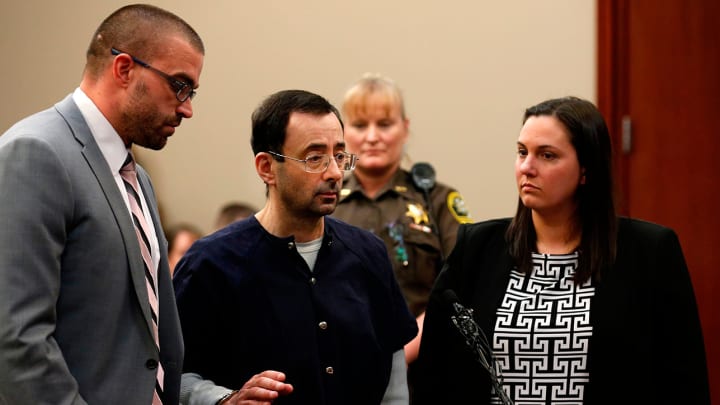Response From Organizations That Enabled Larry Nassar Have Been Reactionary and Too Late

Minutes after former USA Gymnastics doctor Larry Nassar was sentenced to a minimum of 40 and a maximum of 175 years in prison, the U.S. Olympic Committee released a letter to the athletes from CEO Scott Blackmun. It was the latest in a series of reactionary moves made by the organizations that enabled Nassar to flourish as a prolific sexual predator for decades.
In the letter, Blackmun says that, “The USOC has decided to launch an investigation by an independent third party to examine how an abuse of this proportion could have gone undetected for so long. We need to know when complaints were brought forward and to who. This investigation will include both USAG and the USOC, and we believe USAG will cooperate fully. We will make the results public.”
Blackmun’s letter also states that while decertification has been an option, that it will not pursue that route unless USA Gymnastics “does not fully embrace the necessary changes in their governance structure along with other mandated changes under review right now.”
The USOC investigation comes on the heels of the NCAA launching its own investigation into Michigan State’s handling of the Nassar case for potential NCAA violations. NCAA president Mark Emmert said last week that he did not have enough information about Nassar to comment on the situation.
The USA Gymnastics executive leadership—chairman Paul Parilla, vice chairman Jay Binder and treasurer Bitsy Kelley—handed in resignations Monday. USA Gymnastics announced on January 19 that it would no longer hold camps at the Karolyi Ranch. The announcement from the sport’s national governing body came while there were still athletes at the facility for a developmental camp.
New USA Gymnastics president and CEO Kerry Perry said in a statement last week that, “It has been my intent to terminate this agreement since I began as president and CEO in December. Our most important priority is our athletes, and their training environment must reflect this. We are committed to a culture that empowers and supports our athletes.”
That statement came just days after five-time Olympic medalist and three-time world champion Simone Biles wrote in a statement that it would be painful to return to the place where she was sexually abused as she trains for the 2020 Olympics in Tokyo.
And it begs some important questions:
Where were these changes over the past 18 months as this case began to unfold?
Where were the independent investigations, the resignations and the much-needed changes to the sport’s national governing body?
Where was the outrage before the last seven days of this sentencing hearing?
Survivors have long been calling for independent investigations into Michigan State and USA Gymnastics. Many of them called out MSU, USA Gymnastics and the USOC during their victim-impact statements. Their calls for investigations into how Nassar was allowed unfettered access to young women for decades, and how the organizations he worked for allowed it to happen, fell on deaf ears.
The U.S. Olympic Committee could have launched its own investigation when the initial Indianapolis Star report broke back in August 2016. Instead, Blackmun insisted that the USOC did not intend to investigate and that the organization believed it had a “state-of-the-art policy regarding sexual abuse and misconduct.”
The NCAA has been absent from the discussion from the beginning. The organization took strong positions when it came to Penn State's Jerry Sandusky scandal—a case that has often been referenced throughout the Nassar case. Yet it did not decide to launch an investigation into Michigan State until after survivors stepped forward to speak for six days.
USA Gymnastics knew about Nassar in 2015 after Sarah Jantzi reported his behavior to Rhonda Faehn, the head of the women’s program. Former president Steve Penny and former board chairman Paul Parilla were both aware of what had happened. Yet, for a full year after Maggie Nichols and her coach came forward, athletes continued to train at the Ranch during the lead-up to the Olympics. That includes training camps for the world championships in 2016, for international assignments in 2016 and even the final camp before the athletes headed down to Rio.
The moves from the U.S. Olympic Committee, from the NCAA and from USA Gymnastics are necessary steps toward protecting future young athletes and discovering how this tragedy was enabled for more than two decades.
It took 156 brave, tenacious women and girls to convince the organizations that enabled Nassar to listen. To hear what they have tried to say more than half a dozen times since 1997. It shouldn’t have taken 156 women and girls bravely facing their abuser in court to get to this point.
